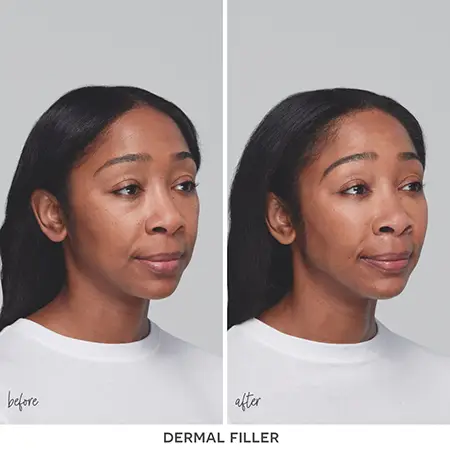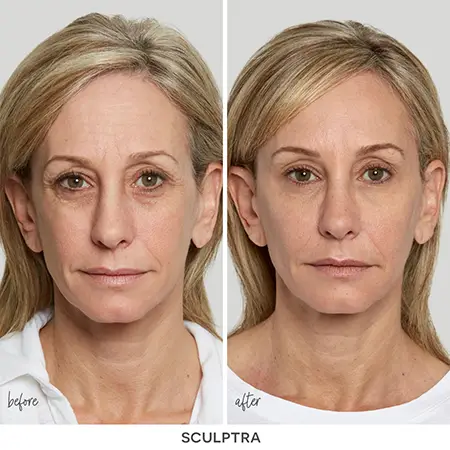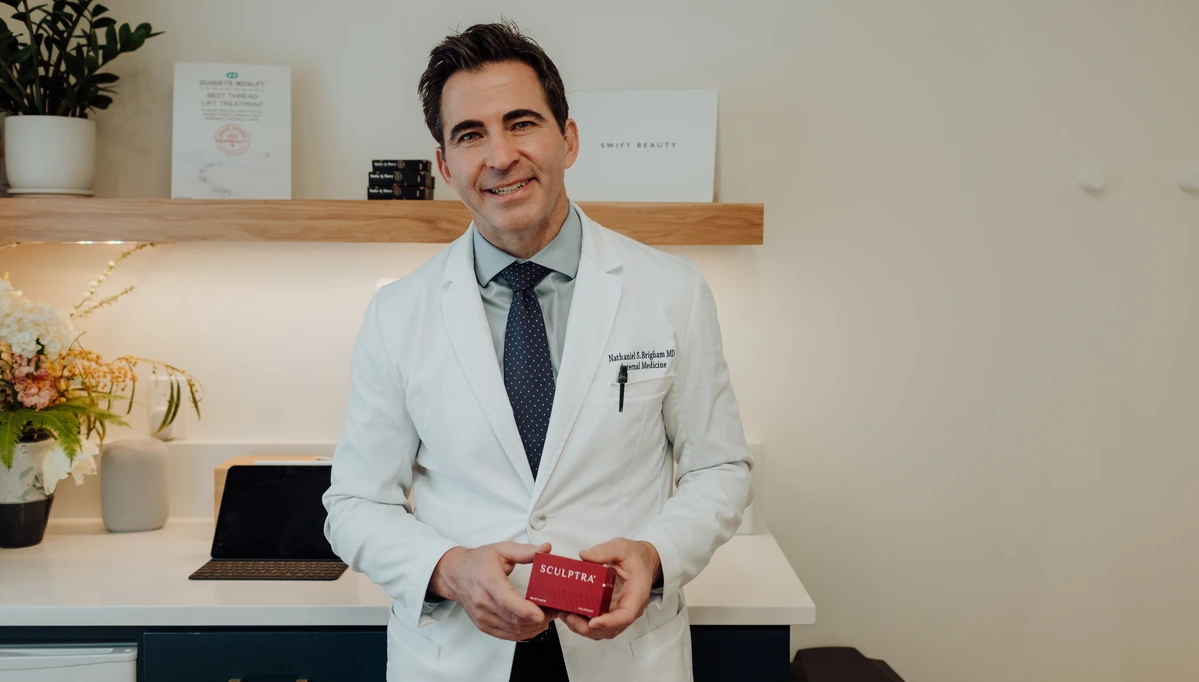How Age, Skin Type, and Treatment Goals Shape the Perfect Midface Rejuvenation Strategy
When it comes to rejuvenating the face, many of our clients want to know what will work best for them: Sculptra or Dermal Fillers. Over the years, injectable treatments like cheek dermal fillers and Sculptra (Poly-L-lactic Acid, PLLA) have become two of the most effective and transformative options available in modern aesthetic medicine. Both address age-related volume loss, but they do so in different ways: one offering immediate lift and contour, and the other building gradual, long-lasting collagen support from within.1
A key concept to understand in facial aesthetics and rejuvenation is the importance of enhancing and/or supporting the midface first. The midface, the area from the lower eyelids to your upper lip, is often called the “anchor” of facial shape.3 If the face was divided into three parts, the mid-face would encompass the central third of the face. Thus, restoring this area doesn’t just give you contoured cheekbones; it can soften under-eye bags, reduce saggy jowls, improve jawline definition, and diminish the folds around your nose and mouth.3 Choosing the right injectable treatment makes all the difference in helping you look refreshed, not over done or underwhelmed.
So, how do you decide between cheek dermal fillers and Sculptra? Both address age-related volume loss effectively, but they operate on fundamentally different principles. The decision often depends on whether you want immediate contouring (cheek filler) or long-term bio stimulation to increase collagen (PLLA), a choice guided largely by your age, skin quality, and treatment goals.
Get Immediate Lift with Dermal Fillers
Dermal fillers act as instant sculpting agents, providing visible contour and lift immediately after your treatment, while PLLA stimulates your body’s natural repair system to restore lost collagen, rebuilding your skin’s internal structure gradually over time.
Dermal fillers are composed of Hyaluronic Acid (HA), a naturally occurring glycosaminoglycan, a type of sugar molecule, that plays a crucial role in maintaining skin hydration, elasticity, and volume. Hyaluronic acid molecules are found throughout the body, but about 50% of the body’s total HA is concentrated in the skin, where it binds up to 1,000 times its weight in water, helping keep the dermis supple and resilient.6 Hyaluronic acid fillers are biocompatible gels that instantly restore lost volume.
Acting like “reinflating a slow-leaking tire,” cheek fillers provide immediate lift, structure, and hydration.6 It’s no surprise they represent the second most popular nonsurgical aesthetic treatment globally, next to Botox, the famous wrinkle reducer for forehead lines and wrinkles around the eyes.
The Rheology of Cheek Filler
The versatility of dermal fillers comes from their varying rheology, which is defined as the study of flow and deformation of matter. In relation to cheek fillers, rheology helps determine how the filler behaves in the skin and deeper tissues.7 Each filler has unique elasticity, cohesivity, and shape change in response to stress allowing clinicians to select the right one for each layer of the face:
1. For Cheek Support and Contour:
As we age, our bones lose mass and the deep fat pads in the face descend. Both of these age related issues cause the face to look aged and saggy. Stiffer dermal fillers with a high Elastic Modulus (G′) act like “structural pillars,” resisting compression and supporting overlying soft tissue when injected deeply on the bone.6 In this technique, dermal filler is placed deeply, close to the bone, to rebuild the structure and support that naturally diminish with age, restoring the cheeks’ youthful projection. Because the filler is injected in a deep plane, surface irregularities are minimal. Brand-name fillers such as Juvederm Voluma, Restylane Lyft, and Restylane Contour are commonly used for this purpose, effectively enhancing the cheekbones and the apples of the cheeks.
2. For Refinement in the Under-Eye Area:
Softer fillers with lower G′ blend seamlessly into the skin for subtle smoothing of fine lines and areas of more delicate skin like the tear troughs.6 This area is best treated once the cheeks have been properly supported and lifted. In younger clients with under-eye hollows, the midface is often naturally well-supported, and a flexible filler alone can effectively rejuvenate the under-eye area.
Because cheek fillers provide instant results, injectors can adjust symmetry and balance in real time. Another major benefit: dermal fillers are reversible. If overcorrection or vascular compromise occurs, hyaluronidase, the body’s ‘natural enzyme that breaks down hyaluronic acid, can dissolve the filler safely and quickly.6
Filler Results and Longevity:
HA dermal fillers typically last around 10-15 months, depending on metabolism and product selection.3 Beyond adding structure, they can also stimulate new collagen, contributing to long-term skin and facial contour improvements.6
Get Steady Rejuvenation Results with Sculptra
What Is Sculptra
Sculptra is not a dermal filler, it’s a biostimulatory injectable that works by prompting your body to produce new collagen. Rather than immediately adding support like cheek filler, it rebuilds the skin’s collagen content, gradually restoring fullness and firmness. After age 20, you lose about 1% of collagen per year.9 Sculptra rejuvenates the facial structures by strengthening the skin’s extracellular matrix (ECM). The ECM is a supportive network that gives skin its strength, elasticity, and volume. It’s primarily made of collagen, which provides strength and firmness, elastin, which allows stretch and recoil, and hyaluronic acid, which maintains hydration and plumpness. Sculptra enhances the fibroblast cells in the ECM act as the builders, producing hyaluronic acid, collagen, and elastin keeping the skin’s structure intact.
How Sculptra Works
Sculptra is injected as a suspension of PLLA (poly-L-lactic acid) microparticles in sterile water, which absorbs over the course of 2-3 days, leaving behind the evenly dispersed PLLA particles. The PLLA microparticles initiate a mild, controlled inflammatory response that activates fibroblasts, leading to increased production of Type I and Type III collagen. This process thickens and strengthens the skin, producing a progressive correction of facial hollowing over time.5
Durability and Natural Evolution
Unlike cheek fillers, Sculptra’s improvements develop over 3–6 months, with results lasting up to two years or more.5 The landmark study for Sculptra aesthetic approval reported sustained softening of nasolabial folds for 25 months after treatment completion.5 Notably, that study ended at 25 months, so the understanding is that Sculptra effects likely persist beyond this and some studies have documented skin quality improvement persisting for 3- 4 years.5
Enhanced Skin Quality
Patients consistently report improved radiance, elasticity, and firmness following PLLA treatments. This rejuvenation stems from widespread boost in collagen content, making it particularly beneficial for those experiencing early skin laxity or crepiness.2
Safety and Technique
Sculptra is not reversible5 like an HA dermal filler, but it is metabolized by the body over months and eventually transformed into lactic acid which is processed through normal cellular pathways and eliminated from the body. The important point is that the PLLA molecule does not become a permanent component of skin or soft tissue. In the early 2000s when Sculptra was first approved, the primary side effect reported was infrequent subcutaneous nodules, which some termed collagen collections. This side effect was thought to be due to inadequate tissue distribution related to inadequate sterile water used for reconstitution and lack of post-treatment tissue massage. The manufacturer recently revised the volume of sterile water used for reconstitution and advised post-treatment tissue massage for five days. Since these changes were implemented, the incidence of post-treatment subcutaneous nodules has dropped dramatically and is now reported to be <1%. The typical Sculptra treatment regimen includes three to four sessions, spaced four to six weeks apart.5
Dermal Filler vs. Sculptra by Age
Younger Patients: Contouring and Prevention
Younger patients, often in their late 20s and 30s, typically seek enhancement and balance, not reversal of aging.3 Cheek fillers are ideal in this group because they offer precision shaping, subtle contouring, and immediate results while supporting the undereye eyes, softening folds around the nose and mouth, and lifting the lower face.
Strategic dermal filler placement can refine cheekbones, offer an overall lifted appearance, and restore natural proportion without altering one’s unique features.3 Additionally, the HA in the dermal filler stimulates mild collagen production, offering a preventative benefit by improving tissue elasticity.7

Mature Patients: Collagen Rebuilding
In the 40s, 50s, and beyond, volume loss becomes more complex due to fat pad descent, bone resorption, and collagen decline.1 The once-youthful facial “triangle” with full cheeks tapering down to a narrow lower face and jawline becomes inverted with lower face heaviness from decent of mid face tissue and the cheeks flattening. In addition, the skin thins and becomes less elastic, leaving fine lines and wrinkles.
Sculptra excels. By stimulating new collagen, it restores the skin’s support system and gradually redefines contours.5 Clinical studies show significant benefits in patients with moderate-to-severe cheek wrinkles, with sustained improvement over two years. For those with mild laxity or thinning skin, PLLA helps thicken the dermis and improve tone long-term.5 In addition, the activated fibroblasts help sustain optimal HA production and retention—both are essential for firm, plump, youthful-looking skin.

HA vs. Sculptra: A Side-by-Side Look
| Hyaluronic Acid (HA) Fillers | Sculptra (PLLA) | |
|---|---|---|
| Primary Goal | Immediate volume, lift, and precise contour | Long-term collagen stimulation and improved skin quality |
| Speed of Results | Immediate correction | Gradual improvement over months |
| Duration | Around 12 months | Up to 25 months or more |
| Candidacy Focus | Ideal for younger patients or those seeking fast results | Ideal for mature skin with laxity or thinning |
| Key Advantage | Reversible with hyaluronidase | Strengthens collagen network for natural firmness |
| Main Risk | Rare vascular events or swelling if placed too superficially | Rare nodules minimized by precise preparation and massage |
| Protocol | Usually one session | Two to three sessions |
Combination Dermal Filler and Sculptra
Combining PLLA (Sculptra) with Hyaluronic Acid (HA) fillers often produces the best results. While PLLA stimulates long-term collagen production, post-menopausal skin may have reduced fibroblast activity and thinner dermis, which can limit the speed and degree of volumization on its own.5 Adding HA cheek fillers provides immediate structural lift and midface support, enhancing cheek projection and subtly improving jowls while the PLLA gradually remodels the skin below the cheeks from within³. This dual approach addresses both short-term contour needs and long-term tissue quality, creating a more harmonious, natural, and lasting rejuvenation for aging skin.8
This dual strategy is particularly effective for those seeking improvement in jowl lift, jawline tightening, and cheek projection. Here, dermal fillers, such as Juvederm Voluma or Restylane Lyft, are placed deep on the periosteum of the chookbones to add support and lift to the mid-face. The sculptra component is placed via cannula in the area below the cheeks to tighten the saggy and crepey skin which also helps tighten the jawline. This dual approach provides immediate cheek structure, reducing shadows and restoring contour, while Sculptra reinforces that framework in the area below the cheeks by rebuilding collagen over time and tightening the skin which also increases the lifting of the jowls and softening of the nasolabial folds.
Younger patients might start with HA dermal fillers to contour and later integrate Sculptra preventatively; mature patients benefit from both volumizing with cheek fillers and collagen induction via Sculptra for true structural restoration.
The Takeaway: Sculpt Now or Strengthen Over Time

Whether you’re drawn to the instant sculpting of cheek filler or the gradual collagen rebuilding of Sculptra, the key lies in a tailored, holistic approach. Your ideal plan should consider not just where volume is missing, but why, and how your skin will respond over time.
At Aluma Aesthetic Medicine in Portland, Dr. Nathaniel Brigham combines advanced anatomical understanding with years of aesthetic expertise to craft custom treatment plans that restore natural beauty and confidence.
Book Your Personalized Midface Consultation
Curious about which treatment is right for you? Schedule your cheek filler or Sculptra consultation at Aluma Aesthetic Medicine in Portland. Whether you’re looking for immediate contour, subtle lift, or gradual collagen renewal, our team can help you achieve true-to-you rejuvenation with precision and artistry.
Works Cited
Readable, public-facing citations with direct links to DOIs or publisher pages.
- Cotofana, S., et al. The Anatomy of the Aging Face: A Review. Facial Plastic Surgery, 2016. https://doi.org/10.1055/s-0036-1582231
- Fabi, S., et al. Effectiveness and Safety of Sculptra Poly-L-Lactic Acid Injectable Implant in the Correction of Cheek Wrinkles. Journal of Drugs in Dermatology, 2024. Publisher page
- Moradi, A., et al. A Unified Approach to Facial Contours and Volume Correction: The Role of the Cheek and the Chin. Plastic and Reconstructive Surgery Global Open, 2024. https://doi.org/10.1097/GOX.0000000000006219
- Narins, R. S., et al. A Randomized Study of the Efficacy and Safety of Injectable Poly-L-Lactic Acid Versus Human-Based Collagen Implant in the Treatment of Nasolabial Fold Wrinkles. Journal of the American Academy of Dermatology, 2010. https://doi.org/10.1016/j.jaad.2009.06.037
- Signori, R., et al. Efficacy and Safety of Poly-L-Lactic Acid in Facial Aesthetics: A Systematic Review. Polymers, 2024. https://doi.org/10.3390/polym16182564
- “Sculptra versus HA: The Midface Filler Debate.” Aesthetics Journal. Publisher page
- de la Guardia, C., et al. Rheologic and Physicochemical Characteristics of Hyaluronic Acid Fillers: Overview and Relationship to Product Performance. Facial Plastic Surgery, 2022. https://doi.org/10.1055/s-0041-1740148
- McKee, D., et al. Effective Rejuvenation with Hyaluronic Acid Fillers: Current Advanced Concepts. Plastic and Reconstructive Surgery, 2019. https://doi.org/10.1097/PRS.0000000000005568
- Savoia, P., et al. Dermatologic Therapy, 2019. https://doi.org/10.1111/dth.13017
- Quan, T., & Fisher, G. J. Mechanisms of Skin Aging. Mechanisms of Ageing and Development, 2015. https://doi.org/10.1016/j.mad.2015.04.015
- Brandt, F. S., Cazzaniga, A., Baumann, L., et al. Investigator Global Evaluations of Efficacy of Injectable Poly-L-Lactic Acid Versus Human Collagen in the Correction of Nasolabial Fold Wrinkles. Aesthetic Surgery Journal, 2011. https://doi.org/10.1177/1090820X11409737

